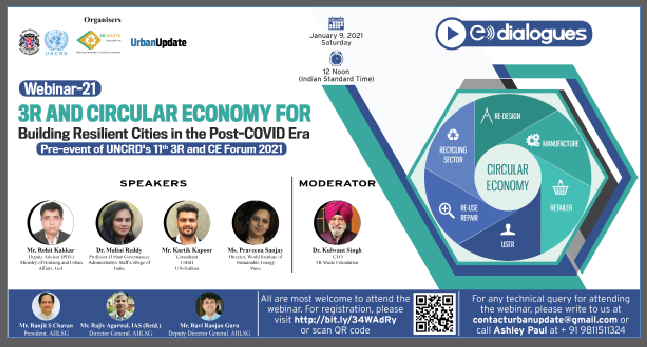3R and Circular Economy are the best approaches to handling the increased quantity of domestic waste that flooded waste management authorities during and after the COVID-19 pandemic. This included, but was not limited to, face masks, gloves, PPE kits etc. In addition to this, the Work from Home culture also meant that the quantity of E-waste also increased manifold. There are, however, many short-term, economically attractive opportunities for resource efficiency, clean energy, and waste reduction. In the long-term, an economic strategy focussed on recycling, circular economy, and clean energy are superior to business as usual.
To move forward, it is essential to tackle inequalities in socio-economic systems, strengthen capacities of local actors such as local governments, bridge the digital divide, and pursue a resilient, inclusive, gender-equal, and green economic recovery. To meet the current and future challenges posed by pandemics such as COVID-19, cities must ensure access to water and sanitation for all, plan for the resilience of systems and infrastructures, and use sustainability metrics in choosing and implementing solutions to the pandemic.
All India Institute of Local Self-Government (AIILSG) and Urban Update, in association with United Cities and Local Governments (UCLG ASPAC), organised the twenty-first edition of the webinar series titled ‘E-Dialogues’ on “3R and Circular Economy for Building Resilient Cities in the Post-COVID Era” on Saturday, January 9, 2021.
To address the concerns, Urban update invited a distinguished panel of experts including Rohit Kakkar, Deputy Advisor (PHE), Ministry of Housing and Urban affairs, Government of India; Dr Malini Reddy, Professor (Urban Governance), Administrative Staff College of India; Praveena Sanjay, Director of World Institute of Sustainable Energy, Pune; and Kartik Kapoor, Project Member, Circular and Low Carbon cities, International Solid Waste Association (ISWA). The event was moderated by
Dr Kulwant Singh, Chief Executive Officer, 3R Waste Foundation.
Dr Singh commenced the webinar by introducing the panelists and invited Rohit Kakkar to speak first. He briefly explained what 3R and the scenario of waste management in India is. Stating that urban India accounts for a third of India’s population and generates 54.7 million tonnes of municipal solid waste, he added that the waste generation in India is increasing by 5 per cent every year because of increasing population and consumption. It is estimated that half of the population will be living in cities by 2050, therefore there would be an increase in the quantum of waste produced. Kakkar then presented a pie chart of solid waste composition in urban India and a flow chart of processing of municipal solid waste. He also talked about the Swachh Bharat Abhiyan. Explaining some of the policies interventions for processing of solid waste, Kakkar said that since the policies were launched in 2014, when the waste processing was only 18 per cent, now when we have provided potential resources to the state, the waste processing has reached up to 67 per cent. He pointed out that there are 86,134 waste segregation wards in our country, out of which 66,140 are wards with 100 per cent source segregation.

Talking about wastewater management, Kakkar said that the focus should be on improving the sewerage coverage in the country so that wastewater can be brought back in the system and reused. He went on to discuss the progress made under the ‘Clean India Mission’. Kakkar also informed how water can be reused and how the urban water bodies can be recharged.Kakkar concluded by saying that circular sanitation economy is not just a project but an overall practice, depending on the requirement of the town. Dr Singh then added to the information provided by Kakkar and invited Praveena Sanjay to speak next. She talked about how ULBs can work on enabling circular economy for waste management in the post-COVID era. She said, “In 2016, around 2 billion metric tonnes of solid waste was generated by cities across the globe. Unhindered population growth and urbanisation is expected to result in further increase in annual waste generation by 70 per cent from 2016 levels to 3.40 billion metric tonnes
in 2050.
According to the Central Pollution Control Board (CPCB), India generates around 55-65 million tonnes of municipal solid waste every year. The Ministry of Environment, Forest and Climate Change estimates that only 75–80 per cent of the total municipal waste gets collected and only 22–28 per cent of this is processed and treated. This means that around 50 per cent of waste remains untreated.
Praveena said that India’s ambitious goal of eliminating single-use plastic by 2022 seems distant, given the current situation of COVID-19 pandemic. The key focus of her presentation was the important challenges in waste management post-COVID. She informed that CPCB had proposed revised guidelines in July 2020 for handling, treating and disposing of waste generated during treatment/diagnosis/quarantine of COVID-19 patients. However, there is no monitoring system in place to check its adherence and compliance. There is also lack of awareness amongst citizens regarding CPCB guidelines for solid waste disposal for households and persons other than COVID-19 patients.
This has resulted in mixing of solid waste and infectious biomedical waste from quarantined homes which ends up in the regular solid waste disposal site for treatment, thus leading to increased fear of contamination and spread of the disease. Due to COVID-19, there has been a surge in production and consumption of household and personal health related products, mainly single-use gloves, masks, equipment like thermometers, electronic gadgets like laptops and mobiles, sanitisation and cleaning products like detergents, hand sanitizers, cleaning wipes, and disposable tissues. The production and consumption of these products is only intensifying due to the impulse of the people to stay safe and protected from the virus. By 2050, half of India’s population is expected to live in cities, and municipal solid waste volumes are expected to triple to about 436 million metric tonnes. In this scenario, a move towards a circular economy mandating the 3Rs is the need of the hour. She emphasised on the fact that cities are key providers of essential services and drivers of waste management, there is an urgent need to strengthen local governments and make them more resilient through the development of a bottom-up and circular approach.
The next speaker, Dr Reddy, emphasised on the need for water to maintain sanitation because of the COVID-19 pandemic. She talked about how rapid and low-cost water service and sanitation provision for communities, health care facilities, and schools is critical to enable handwashing, hygiene, and disinfection. Sanitation workers should have proper training and access to personal protective equipment (PPE), and in many scenarios, a specific combination of PPE elements is recommended.
Dr Reddy then raised her concern on the issue of open discharge of faecal matter. She said that one gram of faeces may contain 100 parasites eggs, 1,000 Protozoa, and 10,00,000 bacteria and virus. She went on to explain co-treatment of septage with sewerage in existing sewage treatment plants (STPs) in Andhra Pradesh. She added that after testing this model of STP in various cities in the state, and after the assurance that the model is successful, the policy decision was taken to convert all 33 STPs into co-treatment plants.
Kapoor, the last speaker of the webinar, extensively discussed topics such as consumption and cities, circular economy as a concept, recycling, circularity cascades in the city, circular and low-carbon cities, and measuring cities’ circularity.
Initially, he explained the meaning and significance of circular economy. Through his presentation, he demonstrated the differences between linear economy, recycling economy and circular economy. He also discussed about various countries that focus on practices that lead to circular economy, such as Circular Economy (CE) indicators of London, and the National CE Indicators System in China. Kapoor then explained the study in Nairobi, Kenya, which shows that there is an urgent need for implanting circular economy as a global concept.
Concluding the webinar, Dr Singh briefly talked about the need for adopting circular economy in India as our natural resources are depleting day by day and adopting both 3R and circular economy as a practice is the only solution.

